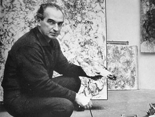
Istrati was an internationally acclaimed exponent of the Abstraction Lyrique movement which was the European equivalent to Abstract Expressionism in America, and included Soulages, Schneider, Germain and Lanskoy amongst others. This magnificent example painted at the height of the movement wonderfully demonstrates his powerful style of sensuously nurtured surfaces and supremacy of colour. This was the apogee of the Modernist era which advocated a purely self-referential autonomy of art and in this work we experience the raw physicality of the paint so dramatically that we no longer read the painting as a two dimensional representation, but as a vibrant and highly energised sculptural object.
Having attended the Academy of Art in Bucharest Istrati arrived in Paris in 1947, where he and his wife, the painter Natalia Dumitresco, were befriended by their compatriot Constantin Brancusi who gave them a studio next to his and helped introduce them to the thriving Paris art scene. Istrati’s uncompromising avant-garde spirit soon became renowned and when he exhibited his first abstract paintings at the Salon des Superindépendants in 1948 the critics applauded his radical new style. The following year in 1949 he held his first one-man show at Galerie Breteau which was so successful the leading art dealers Collete Allendy and Dénise René both invited Istrati to exhibit at their eponymous galleries. In the circle of these highly influential gallerists Istrati found himself at the forefront of the post-war avant-garde along with artists such as Soulages, Deyrolle, Magnelli and Poliakoff with whom he became particularly close. In 1953 he was awarded the prestigious Prix Kandinsky and was appointed to the committee of the Salon d’Octobre and in the next few years he would also serve on the committees of the Salon Comparaison and the groundbreaking Salon des Réaltités Nouvelles.
Istrati developed an international reputation exhibiting extensively worldwide including most notably Gallery Circle and Square, New York, 1953; World Houses Galleries, New York, 1958; Gres Gallery, Wahington D.C., 1958; Galeria de Arts Contemporaneo, Caracas, Venezuela, 1958; Galeria del Naviglio, Milan, Italy, 1959; Kunstverein, Cologne, Germany, 1960; Gallery Hybler, Copenhaguen, Denmark, 1961; Gallery Leohart, Munich, Germany, 1962; Gallery Hilt, Bale, Switzerland, 1963; Hanover Gallery, London, 1964; Gallery Brechbuhl, Genchen, Switzerland, 1965; Gallery Lauter, Mannheim, Germany, 1966, 1972; Gallery Beno, Zurich, 1967; Gallery Tokoro, Japan, 1981; Gallery Praestegarden, Denmark, 1986, Retrospective, Maison des Arts G. Pompidou.
The artist is represented in several major art museums including, Musee d’Art Moderne de la ville de Paris; Musée Nationale d’Art Moderne, Paris; Museo de arte Contemporaneo, Madrid; Kunsthalle Zurich; Bucharest; Sofia; New York; San Francisco Museum; The Hirshborn Museum and Sculpture Garden, Washington D.C.